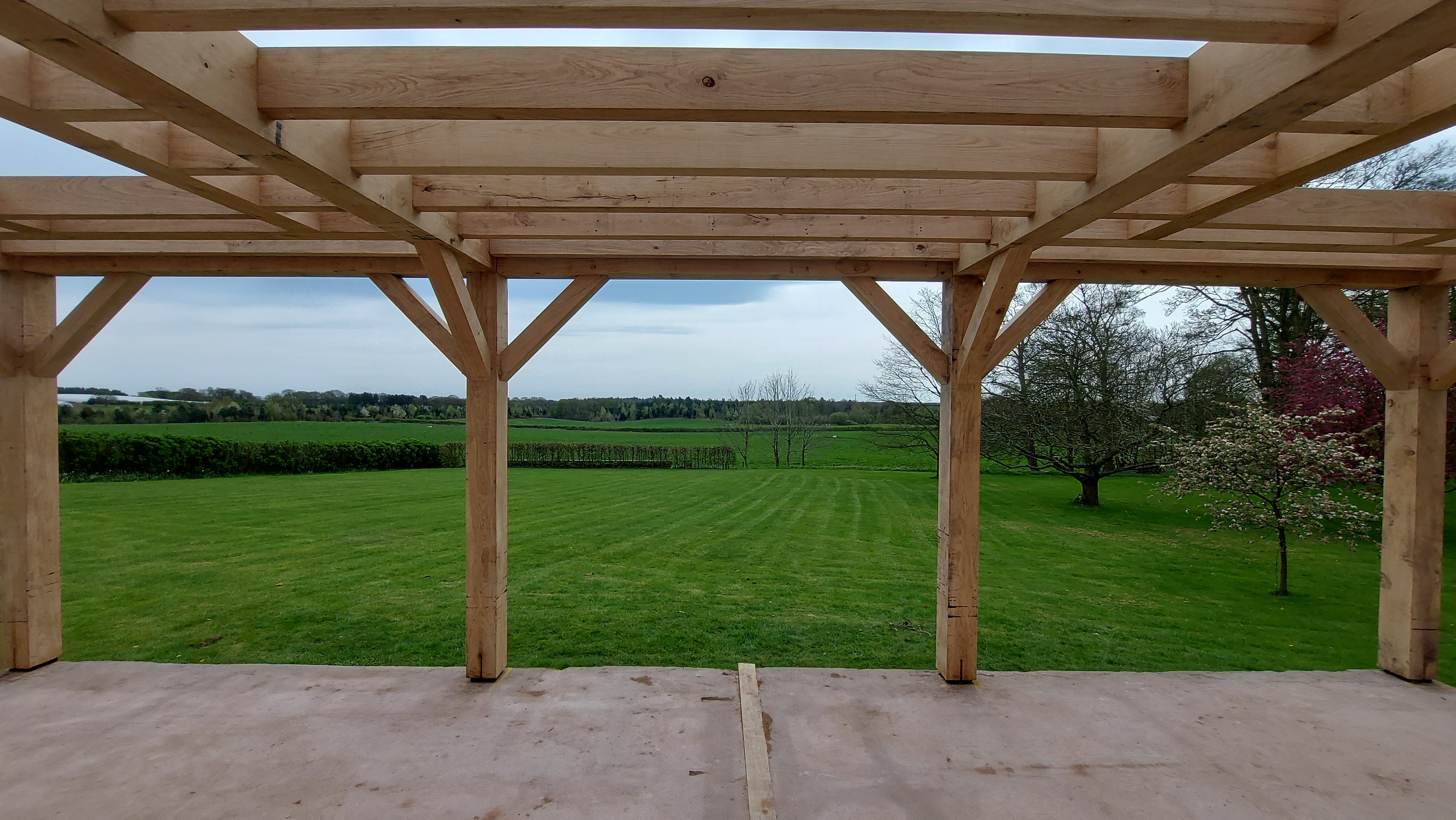Oak timber frame buildings have become increasingly popular among homeowners and property developers looking for durability, aesthetic appeal, and long-term value. Whether you're considering an oak framed annexe building, a single oak framed garage, or even bespoke oak framed buildings, investing in high-quality oak structures is a decision that pays off for generations.
What we will be discovering in this article:
- Sourcing & Harvesting the Oak
- Milling & Seasoning
- Crafting the Frame
- Transportation & On-Site Assembly
- Roofing, Cladding & Finishing Touches
- Single Oak Framed Garage vs. Multi-Bay Garages
- Oak Frame Garage with Room Above
- Cost of Oak Framed Garage
- When Do You Need Planning Permission?
- When Can You Proceed Without Planning Permission?
- Key Groundwork Considerations
1.Benefits of Oak Framed Buildings
-
Longevity & Durability – Oak is naturally resistant to rot, pests, and adverse weather conditions, ensuring your structure remains strong and stable for decades, if not centuries. Unlike softwoods, oak hardens over time, increasing its resilience.
-
Aesthetic Appeal – The rich grain, warm tones, and timeless charm of oak create an elegant, natural look that complements both traditional and modern settings. The character of oak improves as it ages, developing a unique patina over time.
-
Versatility – Whether you need an oak framed garden shed, a workshop, or a garage, oak buildings can be designed to suit a wide variety of uses. Their structural flexibility also allows for extensions and modifications in the future.
-
Eco-Friendly & Sustainable – Oak is a renewable resource, and when sourced from responsibly managed forests, it has a low environmental impact. Additionally, oak frame buildings are highly energy-efficient, as the dense timber provides natural insulation.
-
Increased Property Value – An oak structure can significantly enhance the aesthetic and financial value of your property. Buyers often seek out high-quality timber buildings, making your investment an attractive feature in the real estate market.
-
Cost-Effective in the Long Run – While the initial cost of an oak framed building may be higher than conventional materials, the durability and minimal maintenance requirements result in lower long-term costs. Oak’s ability to withstand time and weather conditions makes it a financially sound choice.
-
Fast & Efficient Construction – Prefabricated oak frames allow for quicker assembly on-site, reducing labor costs and disruption. This method also ensures precision in design and build quality.
-
Structural Strength & Stability – Oak’s natural strength allows for open-plan designs and spacious interiors without the need for excessive internal supports, offering greater flexibility in how the space is used.
-
Low Maintenance – Unlike some other materials, oak requires very little maintenance. With its natural resistance to decay and pests, you won’t have to worry about regular treatments or replacements.
2.The Process: From Tree to Post in Oak Frame Buildings
Transforming a raw oak tree into a finished oak frame building is a meticulous and highly skilled process. Here’s a breakdown of how this journey unfolds:
- Sourcing & Harvesting the Oak
Sustainably managed oak forests are carefully selected for harvesting. The best oak trees for construction are typically over 80 years old, ensuring maturity, density, and strength. Once felled, the logs are transported to sawmills for processing.
- Milling & Seasoning
At the sawmill, the oak logs are cut into beams and planks according to the required dimensions. Freshly cut oak, known as “green oak,” retains a high moisture content and is easier to work with. While some oak is air-dried or kiln-dried to reduce moisture levels, green oak remains a preferred choice for framing due to its flexibility and ability to tighten over time, improving structural integrity.
- Crafting the Frame
Highly skilled craftsmen use traditional techniques, such as mortise and tenon joints, to shape the oak into precise frame components. These joints are secured with seasoned oak pegs, which naturally tighten as the timber dries. Modern CNC machines may also be used for precision cutting, ensuring a perfect fit during assembly.
- Transportation & On-Site Assembly
Once all components are crafted, the frame is transported to the construction site. The assembly process is remarkably fast compared to other building methods, as the pre-cut joints allow the frame to be erected in days rather than weeks. Cranes and skilled craftsmen piece together the structure, ensuring each beam fits perfectly into place.
- Roofing, Cladding & Finishing Touches
After the frame is assembled, roofing materials such as tiles, slate, or shingles are added. External cladding, insulation, and internal finishes follow, bringing the structure to completion. Depending on the project’s scope, bespoke elements like windows, doors, and custom joinery may be integrated at this stage.
The result is a beautifully crafted, highly durable oak frame building, ready to stand the test of time while adding elegance and value to any property.
3. Oak Framed Garages: Styles, Costs & Options
Single Oak Framed Garage vs. Multi-Bay Garages
A single oak framed garage is an excellent option for homeowners seeking compact yet stylish storage for a vehicle. For those needing additional space, oak frame garage kits can be tailored to include multiple bays or extra functionality.
Oak Frame Garage with Room Above
An oak frame garage with room above (or oak frame garage with room over) is a fantastic way to maximize space, offering options such as:
- Guest accommodation
- Home office
- Studio or workshop
Cost of Oak Framed Garage
The cost of an oak framed garage depends on various factors, including:
- Size and number of bays
- Custom design elements
- Roofing materials
- Additional features such as a room above or integrated storage
Prices typically start from £10,000 - £15,000 for basic oak framed garage kits, but bespoke oak framed garages can cost significantly more depending on specifications.
4. Planning Permission for Oak Framed Buildings
Before starting your oak framed project, it's crucial to consider planning permission requirements. Generally, the need for permission depends on factors such as the size, height, location, and intended use of the structure.
When Do You Need Planning Permission?
- If the building exceeds 4 meters in height (or 2.5 meters when within 2 meters of a boundary).
- If the structure will be used as self-contained living accommodation.
- If the total footprint of outbuildings exceeds 50% of the land surrounding the house.
- If the property is listed or in a conservation area.
When Can You Proceed Without Planning Permission?
- If the structure is considered permitted development, meeting height and placement restrictions.
- If it is used for storage, a garage, or a workshop without residential use.
- If it remains within 30 square meters and follows fire safety regulations.
Always check with your local planning authority to ensure compliance before building your oak framed annexe, oak frame workshop, or oak framed shed. It is ultimately the responsibility of the client to ensure all necessary permissions are obtained, as we are not certified planning consultants.
Often when asked we direct clients to:
https://interactive.planningportal.co.uk/mini-guide/outbuildings/0
Be sure to have a good look through this comprehensive guide and navigate on the tabs at the bottom of the page to go through various buildings and scenarios.
5. Groundworks Considerations for Oak Frame Buildings
The success and longevity of an oak timber frame building depend on well-planned and properly executed groundworks. Preparing a solid and stable base ensures structural integrity, prevents subsidence, and enhances durability.
- Site Preparation – Clear the site of any vegetation, debris, or obstructions to create a level and stable foundation area.
- Soil Type & Drainage – Conduct a soil assessment to determine load-bearing capacity and implement drainage solutions if necessary to prevent water pooling.
- Foundation Options:
- Concrete Slab – A durable and cost-effective choice for garages, workshops, and annexes.
- Strip Foundations – Ideal for buildings with heavy structural loads, ensuring stability on softer ground.
- Piled Foundations – Required for unstable ground conditions where deeper support is needed.
- Access & Utilities – Plan for electricity, water, and drainage connections if required, ensuring compliance with building regulations.
- Ground Leveling & Reinforcement – Ensure the foundation is level and reinforced appropriately for the structure
6. The Bottom Line
Oak framed structures are a fantastic investment, whether you need an oak framed annexe, oak framed garden sheds, or a single oak framed garage. With various options available, from oak frame garage kits to bespoke oak framed buildings, there’s a solution to fit every property and budget. If you're looking for a durable, stylish, and eco-friendly addition to your home, an oak timber frame building is ta great option to consider.


 Back
Back
 February 7, 2025
February 7, 2025  7 min read
7 min read




.jpeg?width=352&name=image1%20(2).jpeg)